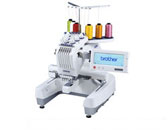PR-620/620C/600II/600IIC
FAQ & Fehlerbehebung |
Fabric/stabilizer compatibility chart
| Fabric/ Garment | No. of Backing Pieces | No. of Topping Pieces | Comments |
|---|---|---|---|
| Terry cloth | 1 tear-away | 1 water-soluble | Increase density and/or satin stitch width.Fine details and small lettering tend to get caught in the terry loops. |
| Satin jacket |
Heavy lining: None Light or no lining: 1 tear-away |
None |
If garment slips in frame, causing alignment problems, wrap inner frame with masking tape or fabric bias tape. This provides a rough surface to grip garment and also helps minimize frame burn. |
| Cotton sheeting | 1 tear-away | None | High-density or highly detailed patterns may require more backing. If so, use two pieces of lightweight backing instead of one piece of heavy backing. |
| Denim | 1 tear-away | None | Reduce speed if needle begins to heat up and the thread breaks. |
| Headwear | Optional | Optional | Change needles more often than usual because the buckram backing dulls needles faster. A lightweight tear-away backing helps reduce thread breaks and regulates thread tension. Use a topping on corduroy or foam cap fronts. |
| Dress shirt (woven) | 1 tear-away | None | High-density or highly detailed patterns may require more backing.If so, use two pieces of lightweight backing instead of one piece of heavy backing. |
| Golf shirt | 1 cut-away | Optional | Use topping for patterns containing small lettering or a lot of detail, and also for pique knits. |
| Canton fleece | 1 tear-away | Optional | Use a topping if the garment has a textured surface, such as a basketweave or pronounced twill. |
| Canvas | 1 tear-away | None | Frame tightly |
| Corduroy | 1 tear-away | 1 water-soluble | A higher stitch density or more understitches, as well as a topping, may be necessary to prevent stitches from sinking into the fabric. |
| Lingerie or silk | 1 or 2 lightweight tear-away | Optional |
Reduce sewing speed. The thread tension should be low. Use topping for patterns with high detail or small lettering.For very fine fabrics, use a thinner thread. Avoid extremely narrow satin stitching on letters or details; instead increase satin stitch width or use a bean stitch. Gently remove (don't pull) backing and topping from garment. |
| Sweater knit | 1 cut-away or adhesive tea-away | 1 water-soluble | Use tightly woven organza or curtain fabric in a matching color as a backing for bulky or "holey" knits. |
| Sweatshirt | 1 cut-away or adhesive tear-away | Optional | Highly detailed patterns may require two layers of lightweight cut-away stabilizer. Use a topping on extra-thick fabrics or with fine-detail patterns. |
| T-shirt | 1 light-weight cutaway or adhesive tear-away | Optional |
Use a topping on patterns with fine detail or small lettering. Tensions should be light. Avoid stitch-heavy patterns. |
Due to the wide variety of fabrics and stabilizers available, the above information should be used as guideline only.
If unsure of a particular fabric/ stabilizer combination, please sew test a sample prior to the finished garment.
Rückmeldung zum Inhalt
Helfen Sie uns dabei, unseren Support zu verbessern und geben Sie uns unten Ihre Rückmeldung.
